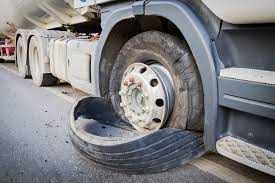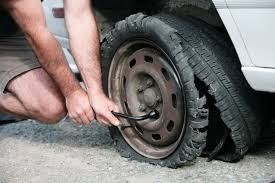Top Causes of Tire Failure…and Manufacturer Defect isn’t one of them!
Nothing is more frustrating than a tire blow-out, or a tire problem requiring an unplanned, early replacement of a new tire. When this happens, we often think the tire wasn’t strong enough or there is some sort of defect in the tire. Manufacturing defect, poor quality or faulty materials are rarely the causes of tire failure. 99% of the time, the causes of tire failure leading to a blow-out or pre-mature tire replacement was completely avoidable with a little more care and attention during routine maintenance or while driving.
Causes of Tire Failure: Under-inflation
One of the main causes of tire failure is under-inflation. Tires that are under-inflated flex more in the sidewall. Excessive flexing causes them to heat up far beyond normal operating temperatures. This problem is compounded when driving at highway speeds during hot weather for long periods of time. When the tire gets excessively hot, the rubber begins to degrade, which if driven on long enough, leads to a rupture in the sidewall of the tire, or tread separation. The result is an immediate and rapid loss of air pressure, often accompanied by a loud bang as the tire explodes.
In addition to the sidewall splitting, the inner liner will usually have evidence that the tire was run at low air pressure before it exploded. When the tire has been removed from the wheel, look for small chunks of burnt looking rubber and dust that has come off the inner liner. If your tire looks like this, it is likely that tire manufacturers, and most extended tire warranty programs, will deny any claim for credit or free replacement.

Causes of Tire Failure: Rapid / Irregular wear due to Mechanical Issues
Misalignment or worn suspension parts are another primary reason a tire does not wear evenly. The tire will be completely worn on one side, or in one area of the tire, but perfectly good, with plenty of tread on the other parts of the tire. The owner has no choice but to replace the tire. Even if only 10% of the tread is worn through, that area will be the weakest and the most susceptible to flats. This condition also contributes to poor traction and ride quality.
There are two tread wear patterns that indicate the type of mechanical problem. The most common is tire wear associated with wheel misalignment. In this situation, one or more of the wheel and tires are going down the road at an angle to the direction of travel, or with too much camber built into the wheel set up. In either case, rubber ends up wearing faster on one side of the tire compared to the other as shown in the photograph on the right. This tire has worn to the cords on one side, but still has plenty of rubber on the opposite shoulder. If the vehicle was aligned correctly, this tire would have worn evenly across the tread, and stayed on the vehicle for another 30,000 or 40,000 miles.
The second wear pattern that indicates a mechanical problem with the suspension of the vehicle is shown below on the left. Broken suspension parts, or worn out and loose bearings or bushings create a wobble in the wheel and tire. Over time the
wobble in the wheel and tire manifests itself in the tire tread rubber, either as cupping on the shoulder tread blocks or as diagonal stripes of wear across the surface of the tread. These wear patterns indicate a serious suspension issue that needs to be addressed for safety reasons and for the sake of the tire tread-life.
While some tires may be slightly more resistant to irregular wear, overtime even the most expensive, premium tires will be replaced early compared to tires on a well maintained and correctly aligned vehicle. Any tire professional or service technician can identify wear patterns on a tire tread associated with mechanical issues. Similar to when tires are under-inflated, tires that exhibit these wear patterns will not be eligible for a free replacement or any sort of pro-rated credit towards a new tire.

Common Types of Dangerous Tire Defects
Tread or Belt Separation – Tread separation is actually the most common type of tire failure among steel-belted radials and can occur due to a defect in either the design or manufacture of the tire. There are many errors in the design or manufacturing process that can make a tire prone to belt separation. There are also many techniques – such as inserting wedges, cushions or safety belts – that tire manufacturers can employ to mitigate tread separation, but not all tire makers choose to take these basic safety measures. Tread failures or exposed belts can cause blowouts or loss of control of the vehicle, as well as rollover accidents, which can cause catastrophic injury or fatality to vehicle occupants.
Bead Failures – We all know it is important to keep our tires properly inflated and that underinflation can cause poor gas mileage or lead to a flat tire or blowout. But few people understand the dangers of over-inflation. Manufacturer recommendations for tire pressure apply to tires when they are brand-new and straight off the assembly line. After some period of road use, a tire filled to manufacturer recommendations may actually be overinflated. If the tire contains a defect in the bead wire, overfilling could cause the tire to explode, which can cause serious injury or even death.
Sidewall Failures – Also known as zipper failures due to the way the tire sidewall looks after it fails, a defect in the tire sidewall can cause the tire to explode while it is being inflated, again with the risk of serious injury or death to persons near the tire at the time.

COMMON TIRE PROBLEMS
Cracking and Bulging
The Diagnosis: This usually comes from hitting a pothole, curb, or debris. Under-inflation and over-inflation put tires at a greater risk of damage from impacts. Large cracks in the sidewall that runs along the rim are either impact-related or caused by chronic under-inflation. Numerous small cracks in the sidewall or tread blocks come from exposure to the elements and age. Rubber, much like your leather interior needs treating to prevent cracking, by using a tire and rubber protectant. Bulging is what looks like a pimple in the tire, most often in its sidewall. It happens when there’s an impact that causes internal damage, but the damage doesn’t show up until weeks or months later. With bulging, you’re looking at buying a replacement and the tire should be removed from service, regardless of the cost. Eventually, it will fail.
Cupping (Also Called Scalloping)
The Diagnosis: It happens when worn or damaged suspension components cause the tire to bounce as it travels, coming down harder on some spots of the tire than others. Bad shock absorbers are the usual cause, though anything that connects the wheel to the rest of the car could be a culprit. Be careful with your diagnosis, though. Even tire shops sometimes incorrectly identify feathering or heel-toe wear as cupping. A wheel that is out of balance may also cause cupping or bald spots to form, though there will be fewer hills and valleys than you’d see with cupping caused by a failed shock absorber.
Heel-Toe
It Looks Like: Feathering, only the ramps run front-to-back along the tire rather than side-to-side. The leading edge of the tread blocks will be worn smooth while the trailing edge will be sharp. The Diagnosis: “[It’s] definitely one of the most common conditions we see,” “Because it’s so common, a lot of people think it’s normal.” Heel-toe wear is typically a symptom of insufficient tire rotation intervals. So check your car’s maintenance schedule and make sure you keep up. Misalignment or worn or damaged suspension bushings, ball joints, and wheel bearings can also cause heel-toe wear.
Feathering
When Operators Fail in Inspection and Proper Maintenance
The majority of truck tire failures are preventable. Truck owners and operators are required by law to routinely inspect and properly maintain vehicle tires.
However, sometimes inspections are completed hastily or not at all, and maintenance, when performed, often fails to address the full scope of a problem. In these situations, important issues can be missed, and vehicles that aren’t fully safe are taken on the road. Failed inspections and maintenance often miss common, fixable problems, such as:
- Excessively worn tires. Tread depth violations were among the most cited during roadside inspections in 2015. Experts recommend replacing tires when they reach a 4/32-inch tread depth. Violations are issued for a depth of less than 2/32 inch.
- Improper tire inflation. Over- or under-inflated tires make it more difficult to safely drive a commercial vehicle. Under-inflation also increases the risk of tires overheating.
- Mismatched tires. In some cases, operators replace only one tire on an axle. Tires of a different size and/or wear affect the stability of a large truck. Different tires also place uneven pressure on the other wheels and mechanical parts, causing trucks to be more prone to rollovers and impacting a driver’s safe distance reaction time to avoid an accident.
- Overloaded tires. Tires are meant to bear certain weight. When a truck is overloaded, too much pressure is put on tires, increasing the chance of under-inflation, overheating, and blowouts.
- Bias and radial tires on the same axle. Experts do not recommend mixing bias and radial tires, because they have different structures. Therefore, they wear and handle differently. Mounting them together causes uneven wear and instability.